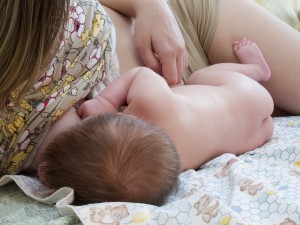
A Chinese study has found that breastfeeding may be linked to lower risk of rheumatoid arthritis in women who nursed their infants.
The study reviewed data from more than 7,300 women aged 50 and older from China, who filled out questionnaires asking about their health and lifestyles, including whether they had breastfed their children. Most of the women had at least one child, and more than 95 percent of moms had breastfed for at least one month.
The average age at rheumatoid arthritis diagnosis was just under 48. The women had been born in the 1940s and 1950s, before China’s one-child policy was instituted in the late 1970s, and at a time when breastfeeding was more commonplace than it is now.
Women who had breastfed were about half as likely to develop rheumatoid arthritis as women who had not breastfed; and the longer a woman breastfed, the lower her risk was of developing the condition later on. The results of this study were published in January, 2014 in the journal Rheumatology.
Rheumatoid arthritis is different from the more common type of arthritis, which is osteoarthritis. Osteoarthritis is wear and tear of the joints, which causes joints to become stiff and painful. Rheumatoid arthritis, on the other hand, happens when a person’s immune system targets the lining of the joints. It can affect other tissues of the body, but joints are usually the most affected.
Doctors still don’t know what causes rheumatoid arthritis, although they believe that a combination of genetic and environmental factors may be involved. Some medical researchers believe that a viral or bacterial infection can cause rheumatoid arthritis in a person who is genetically susceptible; however, no specific bacteria or viruses have been identified as the triggers until now.
In rheumatoid arthritis, a person’s own protein is targeted by the immune cells. Different proteins can be targeted. Lymphocytes, a type of white blood cell, react to the person’s protein, causing the release of cytokines, which are chemical messengers that trigger more inflammation and unrest.
With rheumatoid arthritis, the thin membrane that lines the joints, the synovium, becomes swollen and tender; but the inflammation can spread to other parts of the body or even to organs like the heart, causing pain, fatigue and loss of function.
Women are at higher risk of developing rheumatoid arthritis than men; in fact, up to 70 percent of people who develop this illness are women. Women who have never given birth, or who have recently given birth, are at greater risk.
Close to two million Americans have rheumatoid arthritis. In women, the disease typically develops between ages 30 and 60, whereas in men, it often develops in later years.
There is no medical cure for the illness, though prescriptions can lessen or eliminate symptoms. A natural approach to preventing the disease involves being physically active; not only does exercise keep joints flexible, but it strengthens muscles, which also helps to protect the joints. Eating a healthy diet and getting plenty of sleep are also associated with decreased risk of developing the illness.
By Lisa Pecos